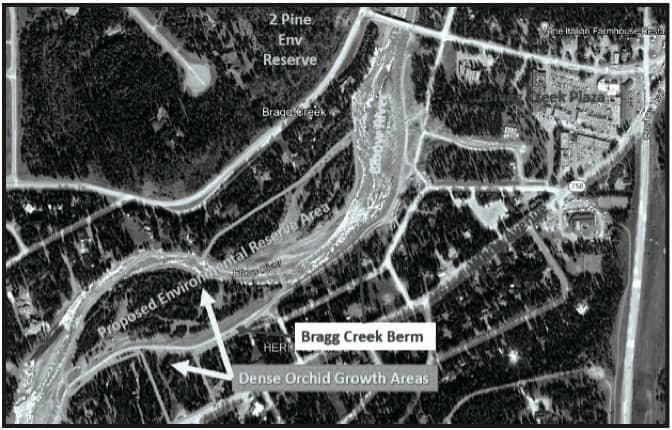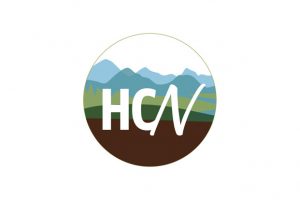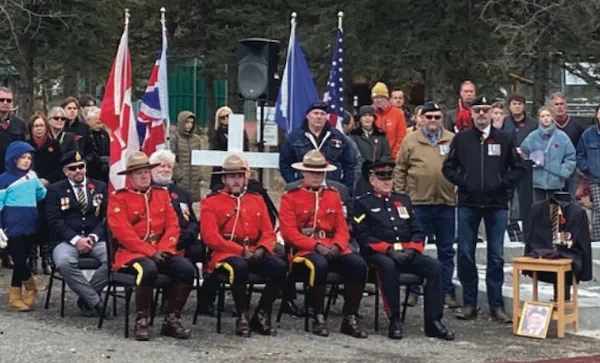On May 23, 2020 some of us living in the Bragg Creek hamlet were alarmed to find swaths of trees bulldozed, creating wide trackways through the undesignated walking paths in the Municipal Reserve along the Elbow River near the gauging station along River Drive South. This was the start of construction of the Bragg Creek flood mitigation berms as a component of the Springbank Offstream Reservoir Project on the Elbow River (before that project was approved) and was an unannounced surprise to most residents. Those of us who walked the area regularly were deeply saddened as the densest clusters of orchid flowers in the Bragg Creek area occur in this riparian environment. These were excavated along with the trees. In August of 2020, when it is difficult to distinguish orchids, a young botanist walked by while I was helping a neighbour in that area and mentioned she was surveying the plants for the contractor. We later learned there was no mention of orchids in the flora report to the berm proponents.
In October 2020 an “orchid group” led by environmental consultant Annette McCullough and comprising Bragg Creek resident amateur botanists and orchid botanists and experts from Edmonton and Winnipeg, marked patches of orchids identified by leaves and seed stalks along Bracken Road north of the Elbow River. These patches were within the footprint of the berm in that area. We successfully transplanted those patches to private lands and the orchid area south of the river, with the permission of the Municipality of Rocky View.

Why should we care about orchids? The plant family Orchidacea is one of the most diversely adapted families of angiosperms (flowering plants) as their many dazzling flower styles attest. Orchids arose about 110Ma ago, some 20Ma after the appearance of flowering plants. The family survived the Cretaceous/Tertiary extinction event (66Ma), after which they rapidly diversified into 30,000 species today and developed unique flower and pollination strategies. Most orchid species are dependent on fungal ectomycorrhizal symbiosis with the mycelial network of Rhizoctonia. This is one of the world’s seven principal fungal networks that distribute nutrients (and sometimes disease) and hormonal communication to orchids and neighbouring plants www.frontiersin.org/articles/10.3389/fpls.2021.647114/full .
Those of you who hike trails in East Kananaskis area know that while orchids are not rare, it is rare to find widespread, dense clusters of these amazing plants. The area near the Elbow River now transected by the berm was home to hundreds of orchids. In June and July in this area we’ve observed Franklin’s Lady Slippers (Sparrow’s-egg orchid), Round- leaved orchids, Venus Slipper or Calypso orchids, Striped Coralroot, Blunt-leaved Bog orchid, as well as the not-so-common insect-eating Common Butterwort. The photographs above were all taken from this orchid-rich area near the Elbow River gauging station in Bragg Creek.
To sustain this concentration and variety of orchids, this area must meet the orchid’s light and soil conditions and must also sustain the subterranean lace of the ectomycorrhizal network to reproduce and distribute the critical nutrients orchids need.

The berm bisecting the area of orchid growth north of White Avenue. Current plans call for seeding the berm slope with a “turf mix” composed of aggressive growth non-native grasses that will stabilize the slope but also likely overcome orchids and their fungal networks underlying the riparian spruce and mixed wood forests to the right and left of the berm.
The “orchid group” has been in communication with the administration of Rocky View County to preserve the orchid flood fringe and floodway area as Municipal Environment Reserve and is asking the municipality to reseed the berm construction area with native grass seed rather than the non-native urban “turf mix” the contractor is scheduled to apply. The Bragg Creek Wild group, led by Bragg Creek resident Renee Delorme, is also in communication with Rocky View County to preserve the orchid area and create a native grass seed policy for the municipality. Bragg Creek Wild is also lobbying for preservation of the area to provide habitat for wildlife in the hamlet area and a movement corridor from the Two Pine Environmental Reserve to the Bragg Creek Provincial Park. The grass seed issue is important; the “turf mix” comprises creeping red fescue, ryegrass, bluegrass, and chewing fescue, all non-native and aggressive growth species meant to stabilize mineral soil. These species commonly out- compete and extirpate native broad-leaved species like orchids, and the fungal network requisite for orchid growth.
A major complication in protecting the area are the legal designations for these public lands. At some point during the last 4 years (and apparently not widely publicized) the area was designated Public Utility Lot from Municipal Reserve. Redesignating the area to Municipal Environmental Reserve with concomitant protection levels will likely be a difficult task. Much of the area lies below “the ordinary high-water mark” of the Elbow River and is thus crown jurisdiction of Alberta Environment and Parks. We are in the process of understanding the legal elements of current land use designations of the orchid areas and the bureaucratic pathways to obtaining protection for these lands.
Our non-profit environmental awareness organization, Experience Journeys, is involved with and supports both the “orchid group” and Bragg Creek Wild and their goal of protecting the orchids and providing wildlife with safe fordings across the Elbow River. We were part of the orchid transplant last October and decided to start a Citizen Science project which provided initial maps and GPS locations of beds of flowering orchids in early July 2021. These were sent, along with supporting pictures, to Rocky View County administration to start the protection initiative. The project aims to better identify and inventory the orchid species and map their extents during their 2022 June-July flowering season and help develop a protection strategy. As part of a separate Citizen Science project with Bragg Creek Wild and Y2Y, Experience Journeys is mapping large mammal wildlife in the Bragg Creek area to obtain a population census, record habitat areas and animal movements to mitigate animal/vehicle collisions and assist in planning development.
Rocky View administration is intent on the contractor finishing the berm construction according to plan but has met with the “Orchid Group” and Bragg Creek Wild to hear our concerns and see if mitigation can be incorporated into the construction plans. Very recently we received a note from Rafael Odie of Rocky View saying they are using a native grass seed mix to meet the resident’s concerns for grass reclamation. We are grateful to the Municipality for their cooperation thus far. We can now focus on obtaining legal protection to conserve the area, and locating pathways across the rip- rap boulders that allow animals to ford the Elbow River without risk of injury. Please contact Bragg Creek Wild or Experience Journeys on Facebook, or Instagram if you would like to add your voice to the cantata of efforts to preserve the beauty of this place for generations to come.
Dave Klepacki and Amarin Dawn

























